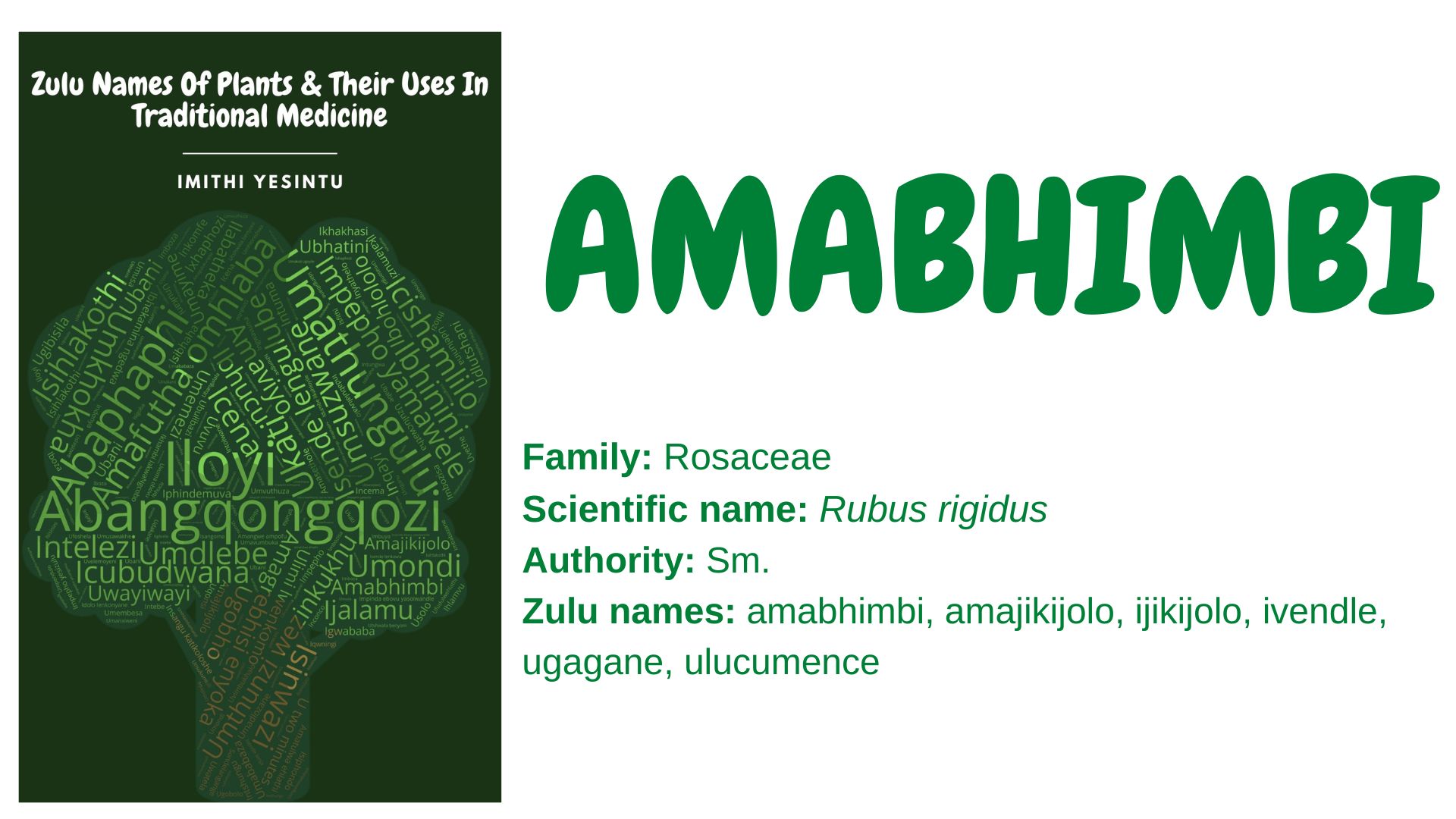Family: Rosaceae
Scientific name: Rubus rigidus
Authority: Sm.
Synonyms: Rubus atrocoeruleus Gust., Rubus chrysocarpus Mundt, Rubus discolor E.Mey., Rubus inedulis Rolfe, Rubus mundtii Cham. & Schltdl.
Zulu names: amabhimbi, amajikijolo, ijikijolo, ivendle, ugagane, ulucumence
Other names: wild brumble, white brumble (English) braambos, braambossie (Afrikaans)
Plant description: R. rigidus is a scrambling shrub that can grow to about 4 m in height. It has dark green leaves with 3 to 7 leaflets that are hairy with serrated margins. The flowers are pale pink to purple flowers with sweet edible fruits that turn purple to black when ripe, and a hairy and thorny stem. It is widespread throughout Africa and can be found growing along forest margins, grasslands, wetlands, and the banks of streams.
Uses:
- The edible fruits are used to make jam, jelly, syrup, and wine.
- The leaves are dried and used to make tea. The leaves are also mixed with other herbs to make different herbal tea blends.
- The leaves are soaked in water that is later used to treat an eye infection that is caused by a latex from the Euphorbia tree.
- The roots are used to make a decoction that is administered as an emetic, to treat heartburn
- The roots are used to decoction that is taken orally to treat complications associated with pregnancy.
- The roots are used to facilitate childbirth.
- The roots are used to make a decoction that is taken as an enema to treat impotence.
- The roots are used in the making of umhlabelo, which is used to speed up bone recovery after it has been fractured or sprained.
- The roots are used to treat acute internal body pain.
- The roots are used to treat toothache.
- The roots are used to make a decoction that is used to treat stomach ache, diarrhoea, and dysentery
- The roots are used to manage fits or epilepsy.
- The roots are used as isihlungu, to treat snake bites.
- The roots are used to make a decoction taken orally to treat cervical cancer.
- This plant is used to treat the itchiness of the body.
Safety precaution:
Using traditional medicine responsibly can enhance your overall health and well-being. Misuse and abuse can lead to complications. You can inquire about the correct use of traditional medicine from a knowledgeable herbalist and practitioner. You can also visit imithiyesintu.co.za or email: info@imithiyesintu.co.za to learn more about traditional medicine
References and further reading:
- Fox, F.W., and Norwood Young, M.E., 1982. Food from the veld. Delta Books, Johannesburg
- Hutchings, A., Scott, A.H., Lewis, G., and Cunningham, A., 1996. Zulu medicinal plants. Natal University Press, Pietermaritzburg.
- Kokwaro, J.O., 1976. Medicinal plants of east Africa. East African Literature Bureau, Nairobi.
- Mukazayire, M.J., Minani, V., Ruffo, C.K., Bizuru, E., Stévigny, C. and Duez, P., 2011. Traditional phytotherapy remedies used in Southern Rwanda for the treatment of liver diseases. Journal of ethnopharmacology, 138(2), pp.415-431.
- Ouma, K.O., 2018. Performance of wild blackberry (Rubus spp.) under conventional production in Kenya (Doctoral dissertation, Egerton University).
- Pooley, E., 2005. A field to wild flowers of KwaZulu-Natal and the eastern regions. Flora and Fauna Publication, Durban.
- Walker, J., 1996. Wild flowers of KwaZulu-Natal. W.R. Walker Family Trust, Pinetown.
- Watt, J.M., and Breyer-Brandwijk, M.G., 1962. Medicinal and poisonous plants of southern and eastern Africa, second edition. Livingstone, London.
You Can Order Your Copy Of The Book By Emailing: info@imithiyesintu.co.za
Feel Free To Add Other Uses Of This Plant In The Comment Section Below:
